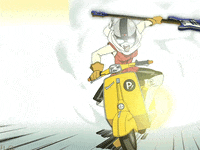|
|
|
May 11, 2016 21:33:30 GMT
|
|
Bleed nipple is the part with the rubber cap in the photo, rubber cap is a good sign as they help prevent corrosion, pull the cap off and soak in penetrating oil then find a full hex socket or spanner to fit, it sometimes helps to try turning it in the doing up direction first as well, you need to go around the car and get all 4 to undo.
Then put the pads back in and buy a bleeding hose which is a rubber hose with a one way valve in the end, fill the reservoir with fresh fluid (dot4) then place the hose on the furthest nipple from the master cylinder with the other end in a clear glass jar, loosen the nipple and get someone to pump the pedal, fluid should come out, keep pumping until it comes through clear with no bubbles ( making sure the mcyl does not run out of fluid, repeat this for each wheel working towards the one closest ypto thge mcyl all being well you will then have brakes.
If this works you then need to check all the steel pipes for corrosion and rubber hoses for cracks, while someone presses on the pedal also check for bulges in the hoses, even if all this check out it is likely the cylinders may start to leak after some use so keep an eye on the fluid level.
|
| |
|
|
|
|
|
|
|
May 11, 2016 21:34:15 GMT
|
With regards to the screw I imagine it's the same as a golf mk1? M6x15? www.vwheritage.com/shop/N0142265/retaining-screw/#esp_pg=2To get the brakes sorted, there should be two bolts around the back that you can undo to get the whole lot off which will take it away from the disc, much easier than trying to get something between the piston and the disc. See the two bolt holes on here... they may be allen heads but I'm unsure. I'm just editing a picture to make it clearer. edit - done.  then use a g-clamp or something to push caliper piston back being careful to take your time, also ensure the brake fluid reservoir cap is removed to allow fluid and pressure release.  |
| |
|
|
|
|
|
May 11, 2016 21:37:52 GMT
|
|
You can buy clamps to push the pistons back in quite cheaply, it is likely the piston has travelled too far and that is why it is leaking, it may push back in ok, may not!
|
| |
|
|
|
|
|
May 11, 2016 21:46:03 GMT
|
As Kevins says, if it's leaking it's possible the ring seals may have come unseated causing it to leak, it may be ok once pushed back, if they still leak, it sounds daunting. I had a similar thing happen to me on my dads brand new VW Touran when the electric handbrake decided to push the piston right out. Putting a caliper together is dead easy. Much easier than I expected so don't worry  |
| |
|
|
taurus
Posted a lot
  
Posts: 1,084
|
|
May 11, 2016 22:09:26 GMT
|
|
Use red grease on the brake rubbers when assembling them. And to be honest I wouldn't worry about the disc retaining screw. Once the wheel bolts are in place they tend to hold the disc in place rather well.
|
| |
|
|
|
|
|
|
|
|
I agree with the above comments...good stuff.
the pistons should push back in with a clamp and maybe even just your thumbs....but yes, take the cap off the master cylinder and put a few rags around and under it to catch any fluid that leaks out. (there is a finite amount of fluid in a contained and specific area inside the calipers and pipes. this fluid will push back out when you push the pistons back in) Fluid may or may not leak out of the master cylinder when you do this, fyi.
If your caliper pistons still leak after pushing them back in, don't fret too much. rebuild kits are available and it is quite simple to do. you may enjoy investigating how it all works. the pistons have to be nice and smooth with no crud build up, which is what usually causes leaking seals. that and age.
also, for bleeding the brakes...the best way to do it so you do not introduce any air into the system:
have a helper pump up the brakes and hold the pedal down...don't let it come back up. then you release the bleed screw on one of the calipers (with the clear hose attached) air and fluid will come out. the pedal will go to the floor. (hold it there). then you tighten the screw and your helper pumps up the brakes again keeping weight on the pedal while you work the bleed screw. Repeat the process until the pedal feels nice and firm. (when the pedal comes back up, air can get sucked into the master cylinder or through your still open bleed screw... especially when the cap is off the master cylinder.) the rubber seal under the cap inside the master cylinder is a bit like a bellows and expands and contracts with the fluid level. this keeps air from getting into the system....
it sounds like things are working fairly well and you should be reassembling in no time.
the retaining screws can be stubborn....I have drilled a few out in my day....I do like to have them in there, but they are not totally necessary if you are in a bind.
A note to Jackeria: yeah, those electronic parking brakes are a pain...probably a 2006 model.....
keep at it!
Jp
|
| |
I know its spelled Norman Luxury Yacht, but its pronounced Throat Wobbler Mangrove!
|
|
|
|
|
|
|
I just thought of another good tip for bleeding brakes to help not allow air in the system, what I like to do is get a bit of fish tank tube and a glass or bottle and do this... it's cheaper than buying any extra equipment just make sure you have some brake fluid in the bottle to start with rather than starting dry, enough to cover the end of the pipe.  That way you don't really have to open and close the nipple every time you pump the pedal as after a few pumps when you let off air cant be sucked back up the tube because its submerged  |
| |
|
|
|
|
|
May 12, 2016 14:04:24 GMT
|
|
yes!...great idea. good pic too...that really shows it.
JP
|
| |
I know its spelled Norman Luxury Yacht, but its pronounced Throat Wobbler Mangrove!
|
|
|
|
|
May 13, 2016 12:20:51 GMT
|
|
I hate brakes.
In 2 hours last night I achieved nothing except getting soaked in break fluid and inventing new swear words.
The piston I thought was leaking is definitely leaking, there's a sizable hole in the seal which spews fluid everywhere when moved. I can't for the life of me get the piston out of the caliper housing. It's slipped out the front of the caliper bracket and refuses to go back in. There's a pin that prohibits it from sliding back which has something to do with the sliding plates, but regardless, it needs to come off anyway for repair/replace. I couldn't even take photos as fluid was literally everywhere.
Is there any way I can remove the entire caliper/piston from the break line without fluid flushing through, or is this an inevitable consequence?
Bah!!!
|
| |
Last Edit: May 13, 2016 12:25:54 GMT by arsonist
1979 Mk1 Passat Estate 1.6 LS
1996 Mk3.5 Fiesta 1.3 Classic
1997 Mk1 MX5 1.8i
2005 Mazda 3 TS
|
|
|
|
|
May 13, 2016 15:51:50 GMT
|
The front calipers i'd recommend removing from the car and just sending to a brake specialist to get rebuilt. I'm afraid there's not really any way without having to bleed the system. Pushing the pistons back into the caliper is only going to be forcing rust and curse word back into them, and unless you value your time at £0 it's really not that bad to get them done properly. Safety first and all that!  |
| |
|
|
|
|
|
|
|
May 13, 2016 18:02:47 GMT
|
|
It really depends on what state the parts are in, if the piston or bore a corroded they are best sent to a specilist like big red, on the other hand if they are fine is not that difficult to fit new seals, pop the pistons out clean it all up then put back together using brake fluid as a lubricant, just make sure you put the seals in the right way round.
|
| |
|
|
taurus
Posted a lot
  
Posts: 1,084
|
|
May 13, 2016 21:10:56 GMT
|
I hate brakes. In 2 hours last night I achieved nothing except getting soaked in break fluid and inventing new swear words. The piston I thought was leaking is definitely leaking, there's a sizable hole in the seal which spews fluid everywhere when moved. I can't for the life of me get the piston out of the caliper housing. It's slipped out the front of the caliper bracket and refuses to go back in. There's a pin that prohibits it from sliding back which has something to do with the sliding plates, but regardless, it needs to come off anyway for repair/replace. I couldn't even take photos as fluid was literally everywhere. Is there any way I can remove the entire caliper/piston from the break line without fluid flushing through, or is this an inevitable consequence? Bah!!! I wouldn't worry about the fluid leaking out. You will need to flush and refill the system anyway. Using a pressure bleeder it is really quite straightforward. Have you got decent release fluid, like Plusgas? Give the parts a dose and see how they dismantle after that. |
| |
|
|
|
|
|
|
|
|
Hang in there youll get it!
1) To take the calipers off the car: unbolt the 2 bolts on the caliper and the brake line bolt which will be on the caliper at the end of the brake hose. these fittings are soft and can strip easily..so take your time. there are brake line wrenches widely available. Brake lines and hoses are available too, and relatively inexpensive.
****NOTE: you may want to leave the caliper bolted to the car and get the brake line off first...otherwise wrestling with it loose is a pain...
2) To take out the pins holding the pads: you can use a small punch for this, working the pins back and forth until they come out. take your time with them and don't hit them TOO hard, but yeah, you do need to get those things out.
***once the pins are out, that piston should fall right out of there....
3) To remove a piston: close the bleed screw and put a rag in the piston. use compressed air in the opening the brake hose went into (you can even try a bicycle pump) and push that piston out all the way. the rag is there to stop the piston from flying out...which it probably wont do...
***most of the time you can just take the pads out, put the rag in place and gently pump the brake pedal until the piston comes out most of the way...then just pull it out with your fingers....
4) inspect the piston, seal, bore, caliper for any pitting or wear. (especially near the pad side of the piston) the seal will come out with a pick, or your fingers. emery cloth will clean up minor pitting and crud, but any pitting that will damage a new seal or allow fluid to leak is a problem.
6) clean everything really well and investigate finding rebuild kits on ebay, VW, parts stores, etc....
7) prime and paint the parts, reassemble and enjoy!
JP
|
| |
I know its spelled Norman Luxury Yacht, but its pronounced Throat Wobbler Mangrove!
|
|
|
|
|
May 17, 2016 22:11:30 GMT
|
|
If the tone my my post isn't obvious in the next few sentences, then FYI, I'm REALLY curse word off!
Got an impact screwdriver today to knock the rotor screw out from the last brake disk. The damn thing is stuck to hell though, and now the screw head has totally stripped. I tried heating the sucker up to break any corrosion on the inside, nothing. I followed some tutorials on creating a ledge in the screw and hammering the screw round with a hammer and punch, nothing.The screw head is pretty buggered now, and it's showing zero signs of moving.
I've literally no idea how to get the damn thing out. Must have spent 2/3 hours fightin it tonight with zero luck. Very very annoyed!
On the plus side, I did manage to pull the calliper with the broken seal off. Got the piston out, but can't find any rebuild kits. Anybody got any suggestions?
Grrrr!
|
| |
1979 Mk1 Passat Estate 1.6 LS
1996 Mk3.5 Fiesta 1.3 Classic
1997 Mk1 MX5 1.8i
2005 Mazda 3 TS
|
|
taurus
Posted a lot
  
Posts: 1,084
|
|
May 17, 2016 22:20:15 GMT
|
|
Are you able to drill the screw out? It's what I usually do when they're seized solid.
|
| |
|
|
|
|
|
May 17, 2016 22:30:14 GMT
|
|
Try an ez/easy out
..
|
| |
|
|
|
|
|
|
|
|
Just drill the end off, it should be a countersunk head so you only have to drill to the bottom of the taper and you'll be able to take the disk off. Then you might be able to grip the threaded part of the screw with mole grips and get it out without having to drill right down into the hole in the hub and risk wrecking the female thread.
Get some decent drill bits, take it slow and use lots of lube ;-) Had really good results with Heller Cobalt drills from Toolstation, got all 4 M10 exhaust downpipe bolts off my BMW with them with no snappage or blunting and they're made of 422 stainless.
|
| |
|
|
|
|
|
May 19, 2016 21:26:38 GMT
|
As usual, you guys are awesome  Thanks for the replies. I've calmed down a bit now  Not much of an update really, except I'm going on holiday for 2 weeks so I'm a bit poor at the moment so looking to cheaper this a bit (against all desire). Going to buy a drill when I get back and take the head off that rotor screw. Worst comes to worst I'll hacksaw what's left off and let the rest sit there forever more. Never replacing those screws again! Here's the pesky curse word! Might need to sand down the scratch marks on the rotor! 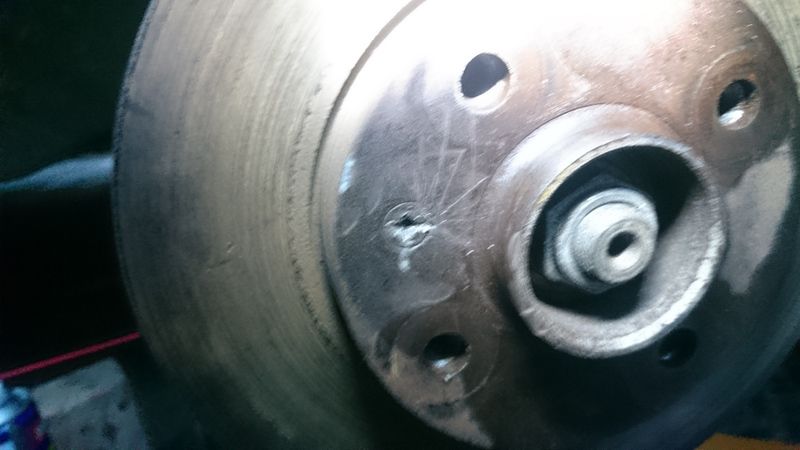 The other rotor came off no bother (there was no screw anyway). A cheap angle grinder (my power tool virginity has now been taken) and wire pad from Halfrauds...(I do Health and Safety/Risk Assessments at work, glad my Manager wasn't about for this!) 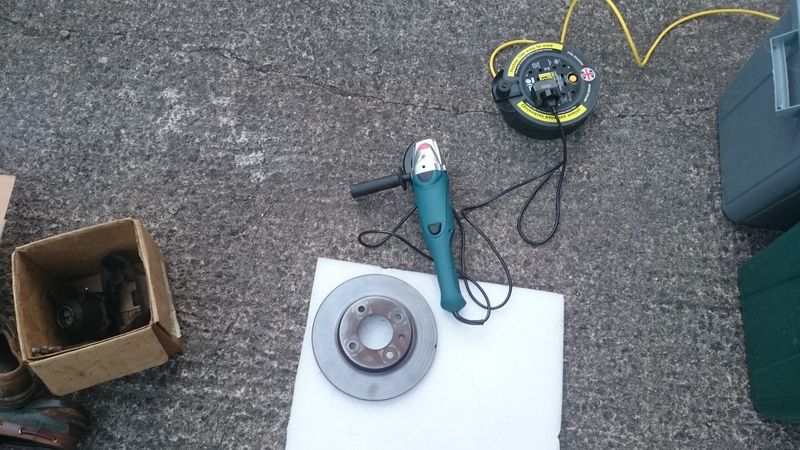 We go from this; 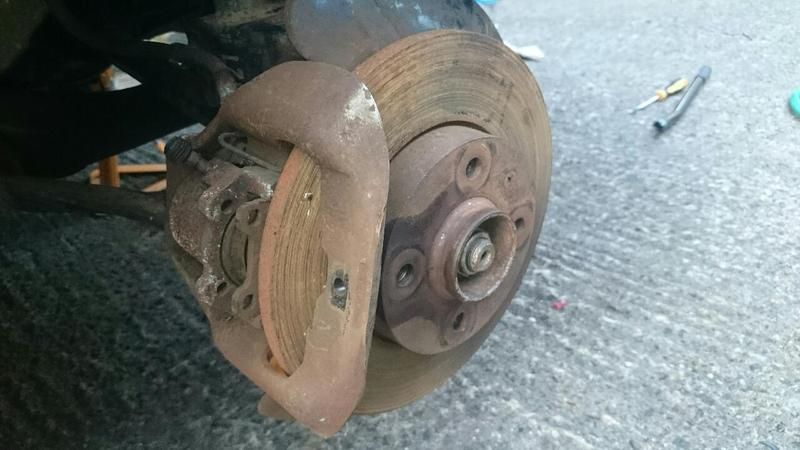 To this; 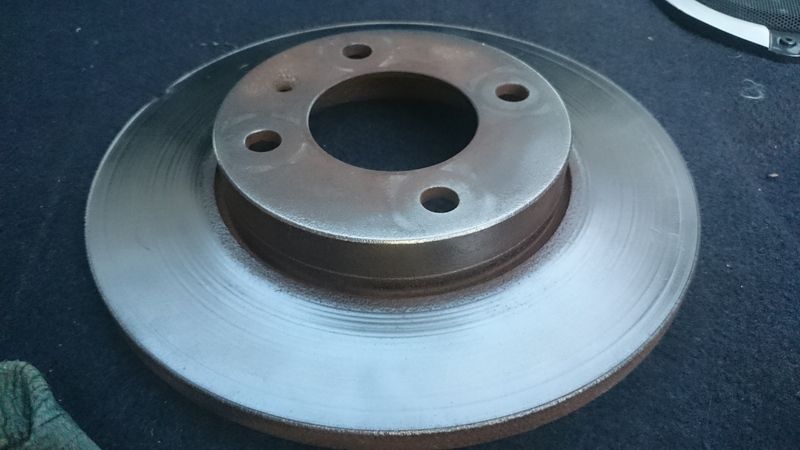  Shiny shiny. I'm not sure if that's acceptable? Will the small chip in the corner be an issue? Am I being a cheapskate for not buying new disks? (I'm buying new pads though as they're only £13). Also, assuming I don't need to grind down anything other than the main rotor/pad surface (both sides obvs)? Mr cheap wire pad didn't enjoy the experience though. Think I need a bulk order as this only did one rotor!  And back on the money front. The current wheels are these; 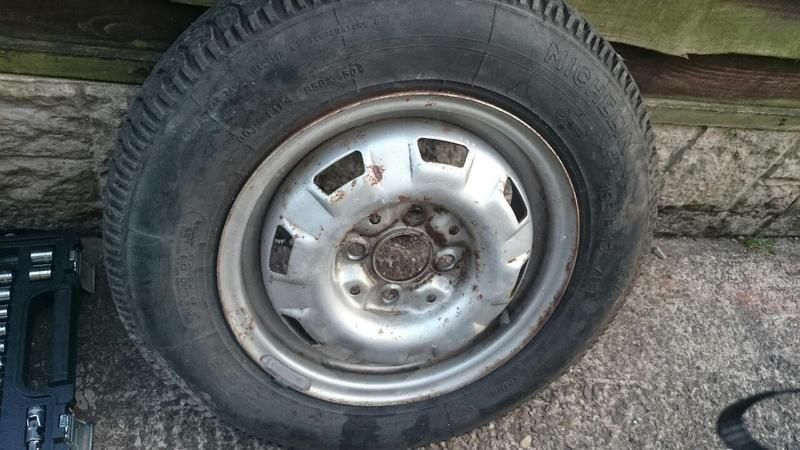 I've sort of run out of cash (at least for expensive tyres) for the moment. They're also got some decent lug nut covers and a VW logo centre cap, so neater than the image looks. Is it worth refurbishing these? What might that entail? I'm assuming I can take all 5 (spare also) wheels to a tyre shop and get the tyre removed/binned (20+ year old rubber) and take the 'alloys' home to sand down and prime/paint? A quick cheap job is preferable at the moment! They don't look in too bad condition, just slightly crusty. Then just back to tyre shop to fit new rubber, and back on the car? I also need an air gun to pop the broken brake piston back out the cylinder to replace the seal (if I can find a replacement). Work has a vehicle repair yard so might ask one of the mechs to give it a blow! Cheers guys! |
| |
Last Edit: May 19, 2016 21:29:48 GMT by arsonist
1979 Mk1 Passat Estate 1.6 LS
1996 Mk3.5 Fiesta 1.3 Classic
1997 Mk1 MX5 1.8i
2005 Mazda 3 TS
|
|
|
|
|
May 19, 2016 21:42:03 GMT
|
|
Yeah you can have a tyre shop do that, might cost you £40~
|
| |
|
|
taurus
Posted a lot
  
Posts: 1,084
|
|
May 19, 2016 21:44:43 GMT
|
|
Some progress which is good to see. If you stuck with the screw I have drills that will shift it.
You want a proper twisted knot wire cup for your angles grinder.
For parts try Brakes International in Bolton. Usually very helpful.
|
| |
|
|
|
|







